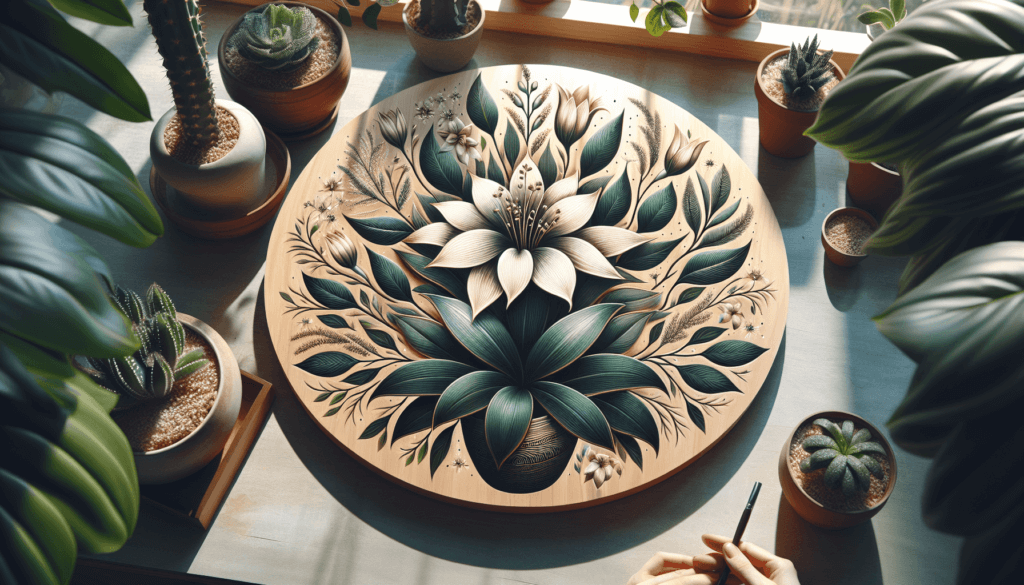Are you struggling to keep your plants healthy and thriving? Look no further than Rousseau Plant Care. With our expert knowledge and passion for plants, we are here to help you create a green oasis in your home or office. Whether you are a seasoned plant parent or just starting your journey, our team of specialists is dedicated to providing personalized advice, tips, and products to ensure your plants receive the care they deserve. Say goodbye to wilted leaves and hello to vibrant, flourishing plants with Rousseau Plant Care.

Choosing the Right Plants
Consider the Light Conditions
When choosing plants for your garden, it’s important to consider the light conditions of the area where you plan to plant them. Some plants thrive in full sun, while others prefer shade or partial sunlight. Take the time to assess the amount of sunlight the area receives throughout the day. This will help you determine which plants are suitable for that specific location. By selecting plants that are well-suited to the light conditions, you’ll set them up for success and ensure they thrive in your garden.
Evaluate the Space Available
Before selecting plants for your garden, it’s essential to evaluate the space available. Consider the size and layout of the area to determine how much space you have for planting. Some plants need ample room to spread out, while others can thrive in compact spaces. Take measurements and make a note of any existing structures or obstacles that could affect the plants’ growth. By evaluating the available space, you can make informed decisions and choose plants that fit well in your garden.
Research the Plant’s Watering Needs
Watering is a crucial part of plant care, and different plants have varying watering needs. Some plants require frequent watering, while others prefer drier soil conditions. Before selecting a plant, take the time to research its specific watering requirements. Consider factors such as the climate you live in and the amount of rainfall your region receives. This research will help you choose plants that align with your ability to provide them with the necessary water they need to thrive.
Preparing the Planting Area
Clean the Area
Before planting your Rousseau plants, it’s important to ensure the planting area is clean and free from debris. Remove any weeds, rocks, or other unwanted materials that may hinder the plants’ growth. Cleaning the area not only improves the overall appearance of your garden but also creates a healthier environment for the plants to grow and flourish.
Improve the Soil
The quality of the soil is crucial for the success of your Rousseau plants. Take the time to assess the soil in the planting area and determine if it needs improvement. If the soil is too compacted or lacks essential nutrients, it’s wise to amend it before planting. Add organic matter such as compost or well-rotted manure to improve the soil structure and provide the plants with the necessary nutrients for optimal growth.
Provide Drainage
Proper drainage is vital for the health of your Rousseau plants. It’s important to ensure that water can flow freely through the soil and not become stagnant around the plant roots. If the planting area lacks natural drainage, you can create a drainage system by incorporating a layer of gravel or installing raised beds. By providing adequate drainage, you’ll prevent waterlogged soil and promote healthy root growth.
Planting the Rousseau Plant
Selecting Healthy Plants
When planting Rousseau plants, it’s essential to choose healthy specimens. Look for plants with vibrant foliage, free from pests or diseases, and with a strong root system. Avoid plants that have yellow or wilted leaves, as this may be an indication of poor health. By selecting healthy plants, you’ll give them the best chance of thriving in their new environment.
Digging the Plant Hole
Before placing your Rousseau plant in the ground, you’ll need to dig a proper planting hole. The hole should be approximately twice the width of the plant’s root ball, ensuring there is enough room for the roots to spread out. The depth of the hole should match the depth of the root ball. Take care not to dig the hole too deep, as this can cause the plant to sink, affecting its growth and health.
Placing the Plant in the Hole
Once the hole is dug, carefully place the Rousseau plant in it and backfill with the soil you removed. Gently tamp down the soil to remove any air pockets and ensure good contact between the roots and soil. Avoid piling soil directly on top of the stem or crown of the plant, as this can lead to rot or damage. Finally, water the newly planted Rousseau plant thoroughly to settle the soil around the roots and provide hydration.
Watering Routine
Understanding the Watering Needs
Understanding the watering needs of your Rousseau plants is essential for their overall health. Different plants have varying water requirements, so it’s crucial to do your research. Factors such as the plant species, weather conditions, and soil type will all influence how much water the plants need. Avoid overwatering, as it can lead to root rot and other issues. On the other hand, underwatering can cause stress and hinder the plants’ growth. Find the right balance by monitoring the moisture levels of the soil and adjusting your watering routine accordingly.
Establishing a Regular Schedule
Establishing a regular watering schedule is crucial for maintaining the health of your Rousseau plants. Consistency is key, as it ensures that the plants receive adequate hydration without being overwhelmed. Consider factors such as the climate in your region and the seasonality of your plants when setting up a watering routine. During hot and dry periods, you may need to water more frequently, while cooler seasons may require less frequent watering. Regularly monitor the moisture levels of the soil and adjust your watering schedule as needed.
Checking for Proper Drainage
When watering your Rousseau plants, it’s essential to check for proper drainage. Poor drainage can lead to waterlogging, which can be detrimental to the plant’s health. After each watering session, observe how the water drains from the soil. If you notice pooling or excessive moisture, it may indicate a drainage issue. To improve drainage, consider adjusting the soil composition or incorporating additional drainage materials such as gravel or perlite. Adequate drainage is crucial for preventing root rot and ensuring the overall health of your Rousseau plants.

Fertilization
Choosing the Right Fertilizer
Fertilization plays a vital role in promoting the growth and vitality of your Rousseau plants. Choosing the right fertilizer is crucial to provide the plants with the essential nutrients they need. Consider the specific needs of your plants, such as their growth stage and nutrient deficiencies, when selecting a fertilizer. Organic options, such as compost or well-rotted manure, are often preferred as they provide slow-release nutrients and improve soil health. Synthetic fertilizers can also be effective if used according to the instructions.
Applying Fertilizer at the Right Time
Timing is key when it comes to fertilizing your Rousseau plants. Applying fertilizer at the right time ensures the plants receive the nutrients when they need them the most. Different plants have varying fertilization requirements, so it’s important to research the specific needs of your Rousseau plants. Generally, it is best to fertilize in the spring when plants are entering their active growth phase. Applying fertilizer too late in the season may result in excessive growth that is vulnerable to cold temperatures or frost.
Avoiding Over-Fertilization
While fertilization is essential for plant health, it’s important to avoid over-fertilizing your Rousseau plants. Excessive amounts of fertilizer can lead to nutrient burn or imbalance in the soil. This can cause damage to the plants and hinder their overall growth. Always follow the instructions on the fertilizer packaging and avoid applying more than the recommended dosage. Monitoring the plants’ growth and appearance can also help you determine if they require additional nutrients or if you need to adjust your fertilization practices.
Pruning and Trimming
Identifying Dead or Diseased Branches
Regular pruning and trimming play a crucial role in maintaining the health and appearance of your Rousseau plants. One of the first steps in pruning is to identify any dead or diseased branches. These branches can negatively impact the overall health of the plant and should be removed promptly. Look for signs such as discoloration, shriveled leaves, or obvious signs of disease. By removing these branches, you’ll prevent the spread of disease and promote healthy growth in your Rousseau plants.
Using Proper Pruning Techniques
Pruning techniques are essential to ensure you’re cutting branches correctly and promoting healthy growth. Always use clean and sharp pruning tools to make clean cuts without causing unnecessary damage to the plant. When pruning Rousseau plants, make cuts just above a bud or leaf node to encourage the growth of new branches. Avoid leaving stubs, as they can lead to disease or pest infestations. Proper pruning techniques will help shape the plant, promote airflow, and stimulate growth.
Promoting Healthy Growth
Pruning and trimming are not only about removing dead or diseased branches but also about promoting healthy growth in your Rousseau plants. By selectively pruning certain branches, you can encourage the plant to grow in a specific direction or shape. This is especially important for large or fast-growing plants that may become unruly or overshadow other plants in your garden. Regular pruning will help maintain the overall size and shape of your Rousseau plants, making them more aesthetically pleasing and promoting a healthy growth pattern.
Pest and Disease Control
Recognizing Common Plant Pests
Plant pests can cause significant damage to your Rousseau plants if left unchecked. Recognizing common pests is essential for effective pest control. Keep an eye out for signs such as chewed leaves, discolored foliage, or the presence of insects on the plant. Aphids, snails, slugs, and spider mites are some common pests that can affect Rousseau plants. Early detection and intervention are key to preventing pest infestations from spreading and causing widespread damage.
Implementing Prevention Strategies
Prevention is always better than cure when it comes to pest control. Implementing preventive measures can help reduce the likelihood of pest infestations in your Rousseau plants. Regularly inspect your plants for signs of pests and promptly remove any affected leaves or branches. Planting companion plants that repel pests or attract beneficial insects can also help deter pests from infesting your garden. Additionally, practicing good garden hygiene, such as removing debris or fallen leaves, can eliminate potential hiding spots for pests.
Using Organic Pest Control Methods
When dealing with pests on your Rousseau plants, consider using organic pest control methods. Organic methods are environmentally friendly and safer for both the plants and the beneficial insects in your garden. Options such as insecticidal soap, neem oil, or introducing beneficial insects like ladybugs can help control pests without resorting to synthetic pesticides. It’s important to always follow the instructions on the pest control products and use them sparingly to minimize any adverse effects on the environment.
Support and Staking
Determining if Support is Needed
Some Rousseau plants may require additional support or staking to ensure their upright growth and prevent them from bending or breaking. Determining if support is needed depends on the specific plant and its growth habits. Taller or top-heavy plants may need support to prevent them from falling over or getting damaged by strong winds. Additionally, plants that grow in vine-like or trailing habits may benefit from trellises or stakes to help guide their growth in the desired direction. Assess the growth pattern of your Rousseau plants and provide support as necessary.
Selecting the Right Support Material
When providing support for your Rousseau plants, it’s crucial to select the right support material. The material should be strong enough to hold the weight of the plant but also gentle enough to avoid damaging the stems or branches. Options such as bamboo stakes, trellises, or cages can all provide the necessary support for different plant types. Consider the specific needs of your Rousseau plants and choose the appropriate support material to ensure their stability and proper growth.
Properly Installing Support
Proper installation of support is essential to ensure its effectiveness. When installing support for your Rousseau plants, ensure that it is securely anchored into the ground. Stakes or trellises should be inserted deep enough to provide stability, especially for taller or heavier plants. It’s important to install the support before the plants reach their full height to prevent any damage or disruption to their growth. Regularly monitor the support system and adjust it as needed to accommodate the plants’ growth and maintain their stability.
Mulching
Benefits of Mulching
Mulching offers numerous benefits for your Rousseau plants and the overall health of your garden. Mulch helps conserve moisture by reducing evaporation from the soil, resulting in less frequent watering. It also acts as a natural weed barrier, preventing weeds from competing with your plants for water and nutrients. Mulch insulates the soil, protecting the roots from extreme temperature fluctuations. Additionally, as mulch breaks down, it enriches the soil with organic matter, improving its structure and fertility.
Choosing the Right Mulch
When selecting mulch for your Rousseau plants, it’s important to choose the right type. Organic mulches, such as wood chips, straw, or compost, are popular choices as they break down over time and improve the soil health. Inorganic options, like gravel or stones, can also be used as mulch in certain situations. Consider the specific needs of your plants, the climate you live in, and personal preferences when choosing the mulch material. Ensure that the mulch layer is not too thick to avoid suffocating the plant roots.
Applying Mulch Properly
Proper application of mulch is essential to reap its benefits effectively. Start by cleaning the area around your Rousseau plants, removing any weeds or debris. Apply a layer of mulch, around 2-4 inches thick, around the base of the plant, ensuring it does not touch the stem or leaves directly. Avoid creating a mulch volcano, as this can promote rot or disease in the plant. Regularly monitor the mulch layer and replenish it as needed to maintain its effectiveness and appearance.
Winter Care
Protecting Plants from Frost
Winter can be a challenging time for your Rousseau plants, especially if you live in a cold climate. Protecting the plants from frost is crucial to prevent damage and ensure their survival. Covering the plants with blankets, burlap, or frost cloth can provide insulation and protect them from freezing temperatures. Avoid using plastic covers, as they can trap moisture and cause more harm than good. It’s also helpful to select frost-resistant plant varieties and plant them in sheltered areas to minimize winter damage.
Providing Adequate Insulation
Insulation is key to protecting your Rousseau plants from the cold during winter. Applying a layer of mulch around the base of the plants can help insulate the soil, preventing it from freezing and protecting the roots. Additionally, you can use materials such as straw or leaves to provide extra insulation around the base or crown of the plants. This layer of insulation helps retain heat and prevents extreme temperature fluctuations that can damage the plants.
Avoiding Overwatering in Winter
Overwatering is a common mistake that gardeners make during winter. It’s important to avoid excessive watering during this season, as the plants’ growth slows down and they require less water. Overwatering can lead to root rot and other issues that can harm your Rousseau plants. Instead, water your plants sparingly and only when the soil is dry. Be mindful of the weather conditions and adjust your watering routine accordingly. By avoiding overwatering, you’ll help your Rousseau plants survive the winter and emerge healthy in the spring.
In conclusion, caring for your Rousseau plants requires careful consideration of their needs and proper maintenance techniques. By choosing the right plants, preparing the planting area adequately, and providing the necessary care throughout the year, you can ensure the health and beauty of your garden. Remember to evaluate the light conditions, research the watering needs, and consider the available space before selecting and planting your Rousseau plants. Establish a regular watering routine, implement proper pruning techniques, and provide support and mulch as needed. By following these guidelines and staying proactive in your plant care, you’ll create an environment where your Rousseau plants can thrive and bring joy to your garden for years to come.


